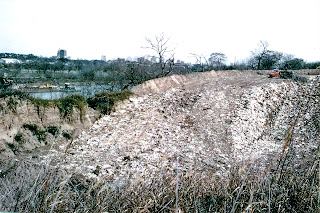The Butler Landfill gravel lot currently covers 3.8 acres in Zilker Park. According to FEMA maps of the 100-year floodplains in Austin, TX, the entire Butler Landfill is within the 100-year floodplain:
I ask:
• Is this cap condition still considered "temporary"?• Have the ACL uses of the revegetated west zone violated the requirements to not "disturb" the landfill cap?• Does the current TCEQ permit for this area allow heavy vehicles to be parked beyond the driveway mats in the revegetated zone?• Would FEMA be concerned that the Butler Landfill's "gravel lot" -- a 3.8 acre site located within the 100-year flood plain -- has been severely compacted and now functions as impervious cover?
The general public seems to be stuck in a situation where heavy trucks/buses/cars are allowed to drive on a parking surface constructed from environmentally mediocre materials (because grasscrete pervious pavement was deemed too expensive for a "temporary" use in 2018) on a fragile landfill cap (the trash below was still wet when the MoPac extension pilings were dug in 1986), in a parking lot that doesn’t meet the requirements for either dust (TCEQ) or shade (COA), in a situation that is agreed by various experts to be “temporary” (TCEQ, PARD, WPD) with no “expiration date” of its ongoing use as a parking lot.
Photo of the Butler Landfill trash in 1966:
Problems with dust in summer of 2023:
Below, the current shade requirements for parking lots:
The lack of shade is one reason that this lot is not currently COA code compliant
During ACL '23, a large area of the revegetated portion was used for storage of heavy equipment, see photo below. The damage to the vegetation is now an area much larger than the driveway mats (see pics below).
Does the current TCEQ permit for this area allow heavy vehicles to be parked beyond the driveway mats?
Below, the landfill cap during ACL staging 2023:
The evidence of widespread damage to the revegetated portion of the landfill cap (the light brown is the matted driveway; the dark soil is the damaged revegetated zone):
After ACL concluded, the Great Lawn was damaged and required new sod to be installed.
As this photo shows on 11/24/23, the Butler Landfill gravel lot is currently being used to store damaged sod:
Below, by November 2023, last summer's top layer of loose rock is now largely missing.
In its place is a severely compacted surface of impervious cement-like structure.
My questions:
• Is this cap condition still considered "temporary"?
• Have the ACL uses of the revegetated west zone violated the requirements to not "disturb" the landfill cap?
• Does the current TCEQ permit for this area allow heavy vehicles to be parked beyond the driveway mats in the revegetated zone?
• Would FEMA be concerned that the Butler Landfill's "gravel lot" -- a 3.8 acre site located within the 100-year flood plain -- has been severely compacted and now functions as impervious cover?














